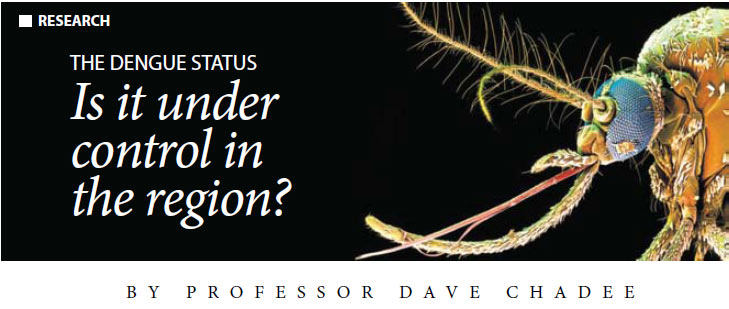 |
 |
 |
|
March 2013 |
Within the Caribbean and Latin American region, Aedes aegypti (L.) is the primary vector of urban Yellow Fever and Dengue Fever (DF), including Dengue Haemorrhagic Fever (DHF) and Dengue Shock Syndrome (DSS). Over the last 36 years, Ae. aegypti eradication and control programmes have been conducted throughout the Caribbean region but in spite of these efforts, DHF has emerged as a serious public health problem. Dengue infection is caused by any of four different serotypes of the arbovirus (DEN-1, DEN-2, DEN-3 and DEN-4). After an incubation period of 2-8 days following an infective bite by the Ae. aegypti mosquito, the disease usually occurs with sudden onset of fever and headache, typically accompanied by any of the following: chills, retro-orbicular pain, photophobia, backache, severe muscle ache and joint ache. High fever may be experienced over 5-6 days. Other significant signs and symptoms include a generalized maculopapular rash, lymph node enlargement, a positive tourniquet test, petechiae and haemorrhagic manifestations, such as epistaxis and gastrointestinal bleeding. In 2012, over three billion people lived in areas where dengue was endemic, which included most counties between latitude 450 N and 350S. Each year an estimated 100 million cases of DF and several thousand cases of DHF occur, depending on epidemic activity in different geographic regions. Currently, DF causes more illness and death than any other arbovirus disease in humans and DHF is the leading cause of hospitalization and death among children in many Southeast Asian countries. The recent emergence and re-emergence of DF and its haemorrhagic manifestations within the Caribbean can be attributed to numerous climatic and anthropological factors including demographic (urbanization) and societal changes, post World War II increases in the air and sea transportation and failure of Ae. aegypti programmes due to poor management and little or no political will. In addition, dengue pandemics within the Caribbean have been attributed to numerous biological factors: the introduction of different dengue strains or serotypes within the Caribbean region; the vector Ae. aegypti developed resistance to conventional insecticides; the vector, especially dengue infected mosquitoes, require long feeding times; changes in the physical size and geographical origin of mosquito strains enhance their vector potential; and higher temperatures can shorten the duration of the life cycle. Behavioural studies have confirmed that Ae. aegypti biting times showed varying patterns, with feeding occurring during the day and early evening in both Africa and the Americas. However, Chadee and Martinez reported the collection of biting Ae. aegypti during both day and night in urban areas. Their results suggested this new behaviour pattern increased transmission of DF and explained the origin of clusters of DHF cases. In the Caribbean region, water drums are the primary breeding sites of Ae. aegypti. These containers are used to store water for drinking, washing, bathing and other household needs. Therefore in theory, control of this vector in water drums should be attained by the provision of an adequate water supply, eliminating two-thirds of the disease vector population and possibly reducing the incidence of DF. However, in the Caribbean region especially in Barbados, Jamaica and Trinidad large sections of the human population live in rapidly expanding urban areas with inadequate water supplies due to rapid population growth and poor urban planning. Although DF was first identified in the Caribbean in the 1950s, it was not until 1979 that the first review of dengue outbreaks in the Caribbean region was reported. The review of the 1977-1978 epidemic outbreak demonstrated the wide geographical distribution of DF cases and outlined the implications for future outbreaks. However, no identifiable or meaningful programme changes were implemented to prevent future episodes of DF and its haemorrhagic manifestations. In 1981, the first major DHF epidemic occurred in Cuba due to an outbreak of DEN-2 following an outbreak of DEN-1 and resulted in 400,000 cases of DF, over 10,000 cases of DHF and 158 reported deaths, after which some action was taken to re-introduce systematic vector control programmes. In 1995, a similar epidemic of DHF occurred in Venezuela with almost 30,000 DF cases and 5,000 DHF cases, and in Brazil where over 120,570 DF cases, 647 DHF cases with 48 deaths were reported in 2008. These outbreaks suggest that vector control strategies previously adopted in the hemisphere did not effectively reduce vector populations to below transmission levels. [Click here for Dengue Statistical Tables] In Trinidad, Dengue serotypes DEN-1, DEN-2 and DEN-4 are endemic but the importation of Dengue 3 (DEN-3) from Southeast Asia to the Caribbean region in 1999 significantly increased the risk and DHF outbreaks were reported from many Caribbean islands. At present much information is available on the vector Ae. aegypti, DF epidemiology and control from Trinidad but little is known from the rest of the Caribbean region. This study provides some information on the epidemiology of DF in the Caribbean region supplemented by data from Trinidad providing an update on the epidemiology and control of DF in the English speaking Caribbean region. This is an excerpt from a status report (2012) done by Professor Chadee, Ron Mahabir and Joan Sutherland on “Dengue Fever Epidemiology and control in the Caribbean.” Professor Chadee is from the Department of Life Sciences, UWI St Augustine. |

